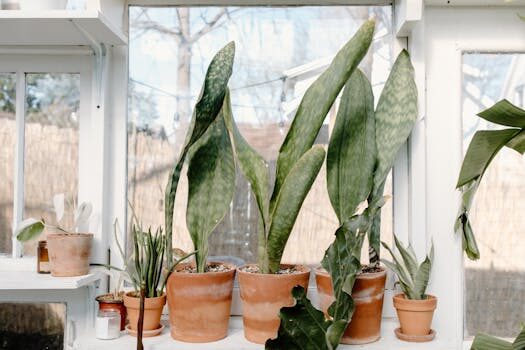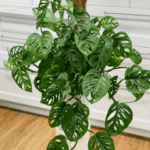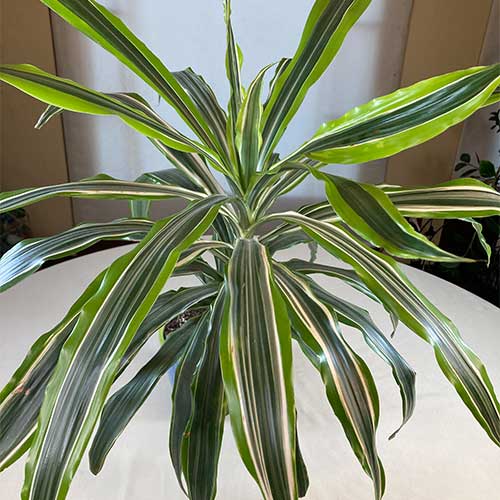Dracaena plants, affectionately known as Dragon Trees, are a popular choice for indoor greenery thanks to their low maintenance and striking appearance. This beginner-friendly houseplant can bring a touch of the exotic into your living space with its sword-like leaves and vibrant red edges.
How to look after a dragon plant indoors
Caring for a dracaena plant indoors involves providing the right balance of light, water, and nutrients. These plants prefer bright, indirect sunlight and can suffer in direct sun. Watering should be done when the topsoil feels dry to the touch, typically every few weeks, but this can vary based on environmental conditions. A well-draining potting mix is essential to prevent root rot.
Dragon Trees also benefit from a consistent temperature range, ideally between 65-80°F, and appreciate a bit of humidity. You can increase humidity by misting the leaves or placing a tray of water near the plant. Fertilization should be done sparingly, usually only during the growing season with a balanced liquid fertilizer.
When it comes to feeding, less is more with Dracaena. A diluted liquid fertilizer can be used once or twice a month during the growing season, and it’s best to avoid feeding in the winter when the plant’s growth naturally slows down.
What is dracaena care and growing guide: how to grow a dragon tree?
The basics of Dracaena care and growing guide include providing your Dragon Tree with the right soil mix, which should have good drainage and be rich in organic material. These plants prefer a slightly acidic to neutral pH level in soil. Regular pruning can help maintain a desirable shape and encourage fuller growth.
Dragon Trees are slow growers, but with the right care, they can reach impressive heights over time. While they are drought-tolerant, they should not be left dry for prolonged periods. Allow the top layer of soil to dry out between watering to ensure you’re not overwatering. To grow a dragon tree successfully, you may need to repot every few years to provide fresh soil and additional space for the roots.
- Provide bright, indirect light.
- Water when the topsoil is dry.
- Use a well-draining soil mix.
- Maintain temperatures of 65-80°F.
- Prune to shape and encourage growth.
What are common problems with dragon trees?
While typically hardy, Dragon Trees can encounter issues such as leaf drop, browning leaf tips, and root rot. Overwatering is a common culprit for many of these problems, leading to soggy soil and a weakened plant. Pests like spider mites and mealybugs can also affect your Dracaena, but they can be managed with regular inspection and cleaning of the leaves.

Too much fluoride in tap water can also cause problems for these sensitive plants. If the leaf tips start browning, consider switching to distilled or rainwater. Take care not to let temperatures drop too low, as Dracaena plants are not frost-tolerant and can be damaged by cold drafts.
Ensuring good air circulation around the plant can prevent many issues, as stagnant air can encourage pests and diseases. Regularly cleaning the leaves with a damp cloth can also help prevent pest infestations and keep your Dragon Tree looking its best.
How to propagate a dragon tree successfully?
Propagation of Dragon Trees is straightforward and can be done through stem cuttings. Select a healthy stem and cut a piece about 4-6 inches long, removing any leaves from the lower half. Allow the cutting to dry for a day or two before planting it in soil. Keep the soil moist, but not soggy, and provide indirect light. Roots should develop within a few weeks.
Another propagation method is air layering, which can be more successful for larger stems. This involves creating a wound on the stem, wrapping it with moist moss, and then covering it with plastic to retain moisture. Once roots have formed, the new plant can be cut from the parent and potted separately.
What are the light needs for a dragon tree?
Dracaena plants thrive in bright, indirect sunlight. Direct sunlight can scorch their leaves, causing them to lose their vibrant coloring. If you’re growing a Dragon Tree indoors, a spot near a window with sheer curtains can provide just the right amount of light. Rotate the plant periodically to ensure even growth.
If your home does not have enough natural light, Dracaena plants can also adapt to fluorescent lighting, making them suitable for office environments or rooms with low natural light. The key is to monitor your plant and adjust its position as needed to prevent leggy growth or pale leaves, which can indicate insufficient light.

How to pot and repot a dragon tree?
When potting or repotting a Dragon Tree, choose a container with good drainage to prevent water from pooling at the bottom. A slightly larger pot is necessary only when the roots begin to crowd the existing pot, usually every 2-3 years. Use a fresh potting mix that’s rich in organic material to give your plant a nutrient boost.
When repotting, gently remove the plant from the old pot, shake off excess soil, and trim away any dead or rotting roots. Place the plant in the new pot and fill it with soil, making sure it’s firmly in place but not packed too tightly. Water the plant thoroughly after repotting to settle the soil and reduce transplant shock.
What are the common pests affecting dragon trees?
Common pests that can bother Dragon Trees include spider mites, scale insects, and mealybugs. These pests can cause damage by sucking sap from the leaves, leading to yellowing, wilting, and stunted growth.
Regular inspection of your Dracaena can help catch these pests early. If you find any, wipe them off with a cloth dipped in soapy water or alcohol. For more severe infestations, you may need to use an insecticidal soap or neem oil solution applied according to the product instructions.
Frequently Asked Questions About Dragon Tree Care
How often should I water my dragon tree?
Water your Dragon Tree when the top inch of the soil is dry, which is typically every 2-3 weeks. Overwatering can lead to root rot, so it’s important to let the soil dry out between waterings.
Monitor the moisture level of the soil and adjust your watering schedule based on the season and your home’s humidity levels. In the winter, when the plant is not actively growing, it will require less water.

Are dragon trees toxic for pets and kids?
Yes, Dragon Trees are toxic to pets and can cause vomiting and drooling if ingested. Keep these plants out of reach of pets and children to avoid any accidental ingestion.
For households with pets, consider choosing pet-friendly houseplants or place your Dragon Tree in an area where your pets can’t access it. In case of ingestion, contact your veterinarian or poison control immediately.
What are the best light conditions for a dragon tree?
Dragon Trees prefer bright, indirect light. Avoid direct sunlight, which can damage the leaves. If you’re unsure about the light conditions in your home, observe the plant’s growth. If it’s not receiving enough light, it may become leggy and its leaves may pale.
Use sheer curtains to diffuse intense sunlight, and if necessary, supplement with artificial lights specifically designed for plants.
How to propagate a dragon tree?
To propagate a Dragon Tree, take a stem cutting and allow it to callous over for a day or two. Plant the cutting in well-draining soil and keep it in a warm spot with indirect light. Keep the soil consistently moist until roots have established.
Air layering is another effective method for propagating larger stems, where you encourage roots to develop on the stem while it’s still attached to the parent plant. Once rooted, it can be potted independently.

What are common pests affecting dragon trees?
Spider mites, mealybugs, and scale insects are common pests that can affect Dragon Trees. Keep an eye out for signs of infestation, such as sticky residue or webbing on the leaves. Regular cleaning and inspecting of the leaves can help prevent pest problems.
If pests are detected, isolate the affected plant to prevent spread and treat it with insecticidal soap or neem oil.
Please enjoy this helpful video on Dragon Tree care, which can provide additional visual guidance on maintaining the health and beauty of your plant:
Caring for Dragon Trees is a rewarding experience that can enhance your indoor space with a touch of nature’s beauty. With these tips and best practices, your Dracaena plant will thrive and grow for years to come.
 Swiss cheese plant care and growing tips: expert advice
Swiss cheese plant care and growing tips: expert advice

Thanks for sharing this comprehensive guide on caring for Dragon Trees! I’ve been considering getting a houseplant that’s both striking and easy to manage, and this post has definitely convinced me to go for a Dracaena. I appreciate the practical tips on light and watering, and the advice on dealing with common pests is super helpful. Can’t wait to bring a touch of the exotic into my home!